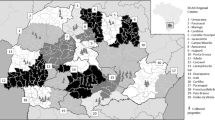Summary
Four hundred and sixty seven cattle were sampled for the presence of trypanosomiasis in two distinct areas of Eastern Uganda. Using sera collected, the agglutination test and two types of indirect fluorescent antibody test were used to examine their value as serological aids to diagnosis. The agglutination test was considered to be of limited use. The indirect fluorescent antibody tests were of value in ascertaining the stage of the disease process and in detecting cases of chronic trypanosomiasis.
Résumé
Des prises enlevées de quatre cent soixante sept bovines dans deux régions distinctes de l'Ugande de l'Est furent examinées pour la présence de la trypanosomiase. L'épreuve agglutinant et deux espèces de l'épreuve indirect d'anticorps flucrescent furent effectués sur les séra ainsi recuellis pour évaluer ces essais comme aides sérologiques à la diagnose. L'essai agglutinant se fut montré d'un utilité borné mais les essais indirects d'anticorps fluorescent furent de valeur pour déterminer la phase du progrès de la maladie et pour la découverte des cas de trypanosomiase chronique.
Sumario
Cuatro cientos sesenta y siete bovinos fueron muestreados para averiguar la presencia de trypanosomiasis en dos diferentes localidades en el este de Uganda. Con las muestras de suero obtenidas, se llevaron a cabo la prueba de aglutinacion y dos tipos de tecnicas indirectas de anticuerpos fluorescentes con el fin de estimar la utilidad de estos metodos como ayuda serologica para el diagnostico. La prueba de aglutinacion fue considerada ser de uso limitado. Las pruebas indirectas de anticuerpos fluorescentes fueron valiosas en la determinacion de el estadio del proceso patologico y en la identificación de casos de trypanosomiasis crónica.
Similar content being viewed by others
References
Bailey, N. M., Cunningham, M. P. &Kimber, C. D. (1967). ‘The indirect fluorescent antibody technique applied to dried blood, for use as a screening test in the diagnosis of human trypanosomiasis’.Transactions of the Royal Society of Tropical Medicine and Hygiene,61, 696–700.
Cunningham, M. P. &Hoeve, K. Van. (1964). ‘Diagnosis of trypanosomiasis in cattle’. International Scientific Committee for Trypanosomiasis Research, CCTA pub. No. 97, 51–53.
Cunningham, M. P. &Vickerman, K. (1962). ‘Antigenic analysis in theTrypanosoma brucei sub-group using the agglutination reaction’.Transactions of the Royal Society of Tropical Medicine and Hygiene,56, 48–59.
Fairclough, W. (1961). ‘Tsetse fly survey in Karasuk’. Veterinary Department Kenya, Annual Report 1961.
Gill, B. S. (1964). ‘A procedure for the indirect haemagglutination test for the study of experimentalTrypanosoma evansi infections’.Annals of Tropical Medicine and Parasitology,58, 473–480.
Gray, A. R. (1960). ‘Precipitating antibody in trypanosomiasis of cattle and other animals’.Nature, London,186, 1058–1059.
Gray, A. R. (1962). ‘The influence of antibody on serological variation inTrypanosoma brucei’.Annals of Tropical Medicine and Parasitology,56, 4–13.
Gray, A. R. (1966a). ‘Immunological studies on the epizootiology ofTrypanosoma brucei in Nigeria’. International Scientific Committee for Trypanosomiasis Research, CCTA pub. No. 100, 57–62.
Gray, A. R. (1966b). ‘The antigenic relationship of strains ofTrypanosoma brucei isolated in Nigeria’.Journal of General Microbiology,44, 263–271.
Killick-Kendrick, R. (1968). ‘The diagnosis of trypanosomiasis of livestock, a review of current techniques’.Veterinary Bulletin,38, 191–197.
Wain, E. B., Burridge, M. T., Pullan, N., Reid, H. W. &Sutherst, R. W. (1966). ‘A survey of trypanosomiasis in the cattle of south Busoga’. International Scientific Committee for Trypanosomiasis Research, CCTA pub. No. 100, 31–33.
Weinman, D. (1963). ‘Problems of diagnosis in trypanosomiasis’.Bulletin of the World Health Organization,28, 731–743.
Wilson, A. J., Cunningham, M. P. &Kimber, C. D. (1967). ‘Application of the indirect fluorescent antibody technique to bovine trypanosomiasis’. East African Trypanosomiasis Research Organization, Annual Report, 1966, p. 28.
Wilson, A. J. (1968). ‘Studies on African trypanosomes’. Ph.D. thesis, University of Edinburgh.
Author information
Authors and Affiliations
Rights and permissions
About this article
Cite this article
Wilson, A.J. Value of the indirect fluorescent antibody test as a serological aid to diagnosis ofglossina-transmitted bovine trypanosomiasis. Trop Anim Health Prod 1, 89–95 (1969). https://doi.org/10.1007/BF02240416
Accepted:
Issue Date:
DOI: https://doi.org/10.1007/BF02240416



